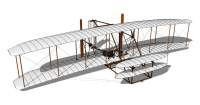








The inventors of the first airplane were Orville and Wilbur Wright. On December 17, 1903, the Wright brothers made the first successful experiment in which a machine (aka airplane) carrying a man rose by its own power, flew naturally and at even speed, and descended without damage.
Around 400 BC - Flight in China
The discovery of the kite that could fly in the air by the Chinese started humans thinking about flying. Kites were used by the Chinese in religious ceremonies. They built many colorful kites for fun, also. More sophisticated kites were used to test weather conditions. Kites have been important to the invention of flight as they were the forerunner to balloons and gliders.
Despite Lilienthal's fate, the brothers favored his strategy: to practice gliding in order to master the art of control before attempting motor-driven flight. The death of British aeronaut Percy Pilcher in another hang gliding crash in October 1899 only reinforced their opinion that a reliable method of pilot control was the key to successful—and safe—flight. At the outset of their experiments they regarded control as the unsolved third part of ""the flying problem"". They believed sufficiently promising knowledge of the other two issues—wings and engines—already existed.The Wright brothers thus differed sharply from more experienced practitioners of the day, notably Clément Ader, Maxim and Langley who built powerful engines, attached them to airframes equipped with unproven control devices, and expected to take to the air with no previous flying experience. Although agreeing with Lilienthal's idea of practice, the Wrights saw that his method of balance and control by shifting his body weight was inadequate.They were determined to find something better.
On the basis of observation, Wilbur concluded that birds changed the angle of the ends of their wings to make their bodies roll right or left.The brothers decided this would also be a good way for a flying machine to turn—to ""bank"" or ""lean"" into the turn just like a bird—and just like a person riding a bicycle, an experience with which they were thoroughly familiar. Equally important, they hoped this method would enable recovery when the wind tilted the machine to one side (lateral balance). They puzzled over how to achieve the same effect with man-made wings and eventually discovered wing-warping when Wilbur idly twisted a long inner-tube box at the bicycle shop.
Other aeronautical investigators regarded flight as if it were not so different from surface locomotion, except the surface would be elevated. They thought in terms of a ship's rudder for steering, while the flying machine remained essentially level in the air, as did a train or an automobile or a ship at the surface. The idea of deliberately leaning, or rolling, to one side seemed either undesirable or did not enter their thinking.Some of these other investigators, including Langley and Chanute, sought the elusive ideal of ""inherent stability"", believing the pilot of a flying machine would not be able to react quickly enough to wind disturbances to use mechanical controls effectively. The Wright brothers, on the other hand, wanted the pilot to have absolute control.For that reason, their early designs made no concessions toward built-in stability (such as dihedral wings). They deliberately designed their 1903 first powered flyer with anhedral (drooping) wings, which are inherently unstable, but less susceptible to upset by gusty cross winds.